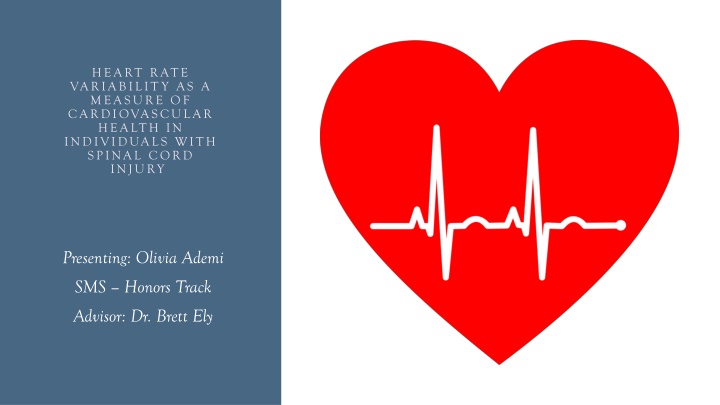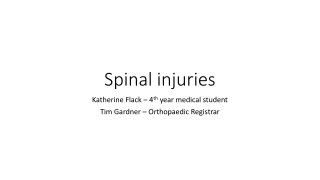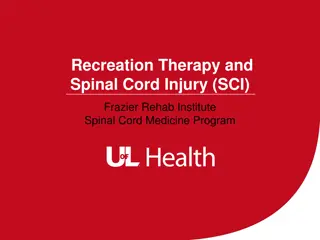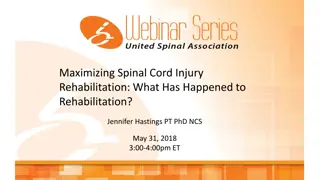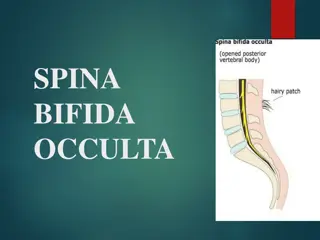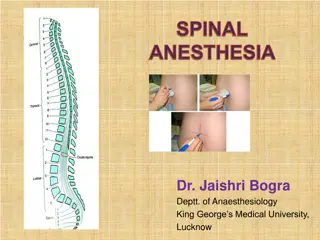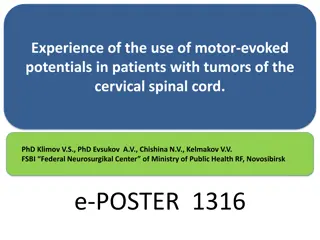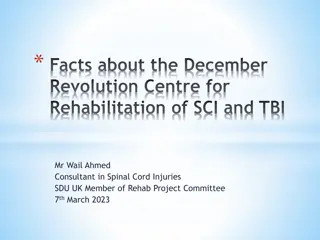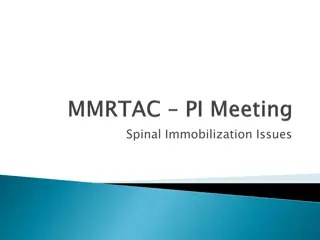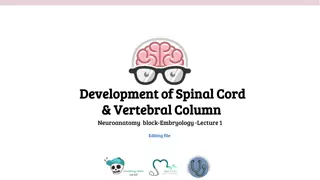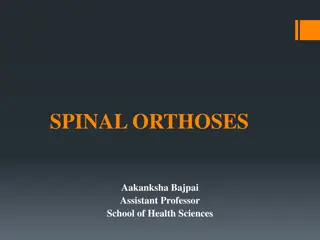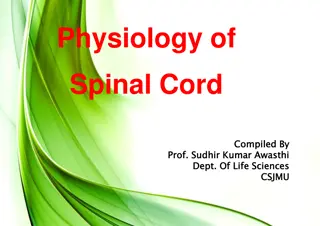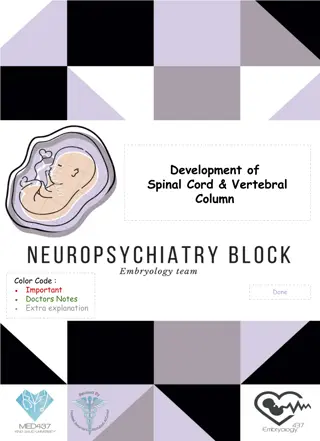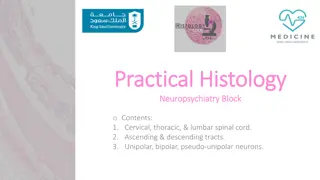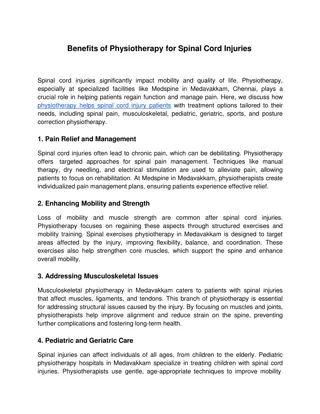Anatomy of the Spinal Cord: External and Internal Structure
External and internal anatomy of the spinal cord, spinal nerves, dermatomes, meninges, reflex arcs, and more, with detailed explanations and illustrations. Learn about the functions and segments of the spinal cord, its extensions, and how it connects the brain to the body.
Download Presentation

Please find below an Image/Link to download the presentation.
The content on the website is provided AS IS for your information and personal use only. It may not be sold, licensed, or shared on other websites without obtaining consent from the author.If you encounter any issues during the download, it is possible that the publisher has removed the file from their server.
You are allowed to download the files provided on this website for personal or commercial use, subject to the condition that they are used lawfully. All files are the property of their respective owners.
The content on the website is provided AS IS for your information and personal use only. It may not be sold, licensed, or shared on other websites without obtaining consent from the author.
E N D
Presentation Transcript
HEART RATE VARIABILIT Y AS A MEASURE OF CARDIOVASCULAR HEALTH IN INDIVIDUALS WITH SPINAL CORD INJURY Presenting: Olivia Ademi SMS Honors Track Advisor: Dr. Brett Ely
BACKGROUND People who have suffered Spinal cord injury (SCI): Impaired or absent cardiovascular sympathetic control Results: autonomic dysfunction lower heart rate variability (HRV) impaired blood pressure control 40% risk of death from cardiovascular disease Not participating in whole-body exercise (Abreu 2016)
HEART RATE VARIABILITY (HRV) HRV as a measure of autonomic function Above T6 loss of sympathetic supraspinal control of the heart (Buker 2018) HRV a measure of the variation in time between each heartbeat by assessing the cardiac autonomic nervous system and positive adaptations after exercise
AUTONOMIC FUNCTION AND HRV HR, HRV, and blood pressure controlled by a balance of sympathetic (fight or flight, stress response) and parasympathetic nervous system (rest & digest) activity Parasympathetic Heart rate HR variability Blood pressure Sympathetic Heart rate HR variability Blood pressure
HRV IN SPINAL CORD INJURY o Patients with SCI lower HRV and a higher risk of cardiovascular disease o Low Frequency (LF): frequency activity in the 0.04 0.15 Hz range o High Frequency (HF): frequency activity in the 0.15 0.40 Hz range o SCI individuals: lower HRV values in the LF compared to able-bodied subjects o Regular exercise: better HRV in SCI subjects (Buker 2018) o Fully reviewed 29 articles to research the effects of spinal cord injury in heart rate variability after exercise
HRV WITH EXERCISE TRAINING o 32 SCI patients: 6 months of exercise training or control group o HRV and and Blood pressure variabilities (BPV) measured o Supine position o Low Frequency (LF) and High Frequency (HF) HRV and BPV were significantly lower in patients with SCI (p =0.008 0.002) (Solinsky 2021) o Impact of exercise: better HRV and lower risk of CV disease
AUTONOMIC FUNCTION AND HEAT Recent studies have shown that passive heat exposure can improve cardiovascular health and autonomic function in able-bodied populations (Ely et al., 2019) Due to their inability to gain the full cardiovascular benefits of exercise, people with SCI may benefit from passive heat exposure (heat therapy) The impact of heat therapy, alone or in combination with exercise in people with SCI, has not previously been studied.
SUMMARY HRV is an essential variable for measuring the balance between sympathetic and parasympathetic systems. Pointer for predicting cardiovascular health outcomes. Overnight HRV is highly correlated with risk of stroke (Binici 2011) Individuals with SCI have lower (impaired) HRV -> loss of innervation and their inability to perform whole-body exercises. This project examines the impact of exercise (rowing machine) and heat therapy as interventions for individuals with spinal cord injury to result in better HRV data and CV health.
PURPOSE / PROPOSAL o The purpose of this project is to examine the impact of exercise, hot water immersion, or combined therapies on overnight HRV in individuals with SCI o This project will explore the impact of spinal cord injury on autonomic function, and whether exercise and/or passive heating interventions can improve heart rate variability and restore cardiovascular health.
Subjects with Spinal Cord Exercise alone (Ex): 20 minutes on an adaptive rowing machine at a moderate intensity Monitoring during heating: Heart rate (HR), Blood pressure (BP), temperature, & overnight Heart rate variability (HRV) Injury (SCI) Exercise + Heat (Ex + HT): 20 minutes on an adaptive rowing machine at a moderate intensity + Lower leg hot water baths for a period of 45 minutes Heat alone (HT): Lower leg hot water baths for a period of 45 minutes
PROPOSED METHODOLOGY Bio strap: counts steps, monitors your sleep, HRV, resting HR, oxygen saturation, & respiratory rate Hypothesis: HRV will be lower in subjects who are part of the exercise alone/ heat alone trial, and combined exercise and hot water immersion will result in higher HRV during overnight and first-morning monitoring
WORKS CITED Abreu, Eliz ngela M rcia de Carvalho et al. Autonomic cardiovascular control recovery in quadriplegics after handcycle training. Journal of physical therapy science vol. 28,7 (2016): 2063-8. doi:10.1589/jpts.28.2063 Binici, Zeynep, et al. Decreased Nighttime Heart Rate Variability Is Associated With Increased Stroke Risk. Stroke, 15 Sept. 2011. Buker, Daniel Bueno et al. Effects of Spinal Cord Injury in Heart Rate Variability After Acute and Chronic Exercise: A Systematic Review. Topics in spinal cord injury rehabilitation vol. 24,2 (2018): 167-176. doi:10.1310/sci17-00028 Solinsky, R., Vivodtzev, I., Hamner, J.W. et al. The effect of heart rate variability on blood pressure is augmented in spinal cord injury and is unaltered by exercise training. Clin Auton Res 31, 293 301 (2021). https://doi.org/10.1007/s10286-020- 00677-2
